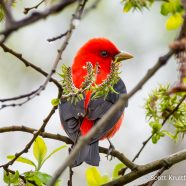Scarlet Tanager
Even the branches of this willow could not block the glow from the fiery feathers of a male Scarlet Tanager (Piranga olivacea). I photographed this bird yesterday as it was staying near eye-level, though it was wary of me and preferred to remain “hidden” like this from afar. These canopy dwellers are so vibrant that even the sharpest lens perfectly locked on and focused always make them look just slightly blurry. They are a flame in the forest. Scott Kruitbosch Conservation & Outreach Coordinator
Read MoreAutumn Leaves
There have been a lot of bright pink autumn leaves to go along with the lemon yellow painted on the trees during this fall foliage season. The past week has yielded some gorgeous October weather. If you look a little closer you may end up seeing something other than a leaf flying off in the breeze – that is a Yellow-rumped Warbler flitting between the trees, one of millions on the move right now. Migration started strong again last night behind another cold front, and it should continue through the weekend. Good birding, and good autumning! Scott Kruitbosch Conservation & Outreach...
Read MoreGoodbye to the Green
Say goodbye to the green leaves because the last of them seem to be leaving the Northeast this week! Some of our oaks and the later changing tree species will be hanging on a bit more, but the colors are really popping now…here, there and everywhere.
Read MoreHouse Finch Pair
It is time to pair off for some of our resident and more hardy passerine species, like the male and female House Finch below. You have undoubtedly heard their rolling and cheery spring song by now in your yard or across your favorite patch. Buds and leaves will be filling up these branches in mere weeks.
Read MoreLong-eared Owl (Asio otus)
Here’s an old photo from one of my point and shoot cameras, zoomed in quite far about 30 times and further cropped, of a Long-eared Owl (Asio otus) roosting in a tree. Taking such a photo during the daylight hours, in the bright winter sun, of such a sensitive bird species should only be done from far away. You do not want to risk disturbing or flushing them from their location as Long-eared Owls are especially sensitive to human intrusion. They will be alarmed easily and fly from the location, exposing them to attacks from other predators and mobbing by songbirds. They will also often...
Read More








